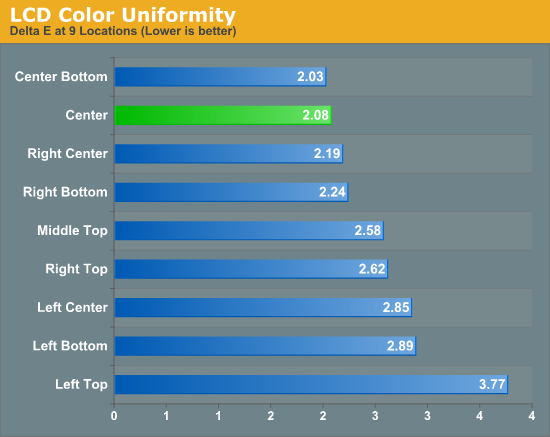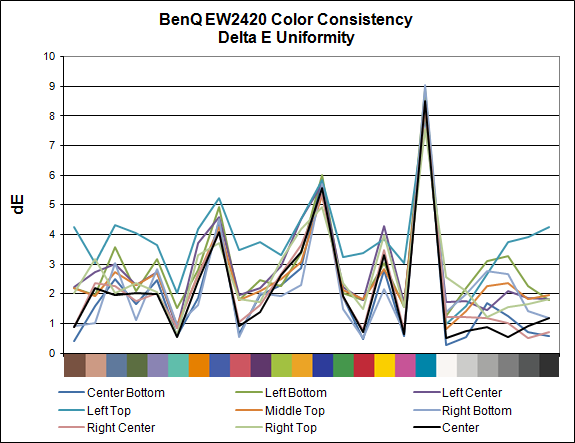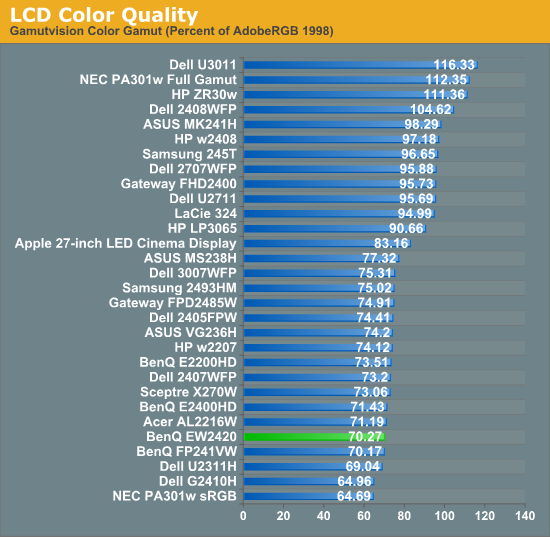BenQ EW2420 Monitor Review
by Chris Heinonen on October 13, 2011 12:00 AM ESTColor Uniformity
The overall color quality of the BenQ was just acceptable with a dE of slightly over 2, and that isn’t limited to the center. Color quality is best at the center and middle-bottom of the screen, with the error level getting higher at the top and corners of the screen.



This is a pattern that we will see repeated when we get to the brightness uniformity charts as well. Most likely this is caused by unevenness in the LED backlighting across the screen, which influences the color quality as a result. With a dE that doesn’t fall below 2 anywhere on the screen, the BenQ isn’t a display that can be recommended for serious print work, but for day-to-day use it should be good enough. As with most displays the highest dE errors occur in colors that are a majority blue, and these errors are less visible to the eye than if the colors were mostly red or green. Grayscale tracking was very good overall, and that’s the most important element of image as far as human vision is concerned.
Color Gamut


The BenQ EW2420 has LED backlighting but still only covers the standard sRGB colorspace and not the AdobeRGB space. We see in the gamut chart that it covers around 70% of the AdobeRGB space, which is average. This also contributes to the higher dE values as some of the color samples used in that test fall outside of the sRGB gamut.










47 Comments
View All Comments
Lyrick_ - Thursday, October 13, 2011 - link
They're perfect with swivel, I could not function without it. 16:9 for media consumption and gaming. 9:16 for document reading and developing.16:10 is going away, hopefully forever.
TegiriNenashi - Thursday, October 13, 2011 - link
"16:10 is going away, hopefully forever. "People would eventually get tired looking the world through short embrasure even faster than they got bored with 3:4. Many people living rooms have limited widths to the only way for TVs to go bigger is getting more height.
kmmatney - Thursday, October 13, 2011 - link
16:10 is still better for gaming.TegiriNenashi - Thursday, October 13, 2011 - link
For me ideal AR is 16:11 -- compromise between 4:3 and 16:10. Thank you hollywood for ridiculous letterbox (2.55:1!). F..king "Director Artistic Intent"IceDread - Friday, October 14, 2011 - link
16:10 is superior for work and gaming so yeah.IceDread - Thursday, October 13, 2011 - link
I appreciate anandtech continues testing of screens and that input lag is tested.However, it's really annoying with all these small screens.. I really would like to see more 30" screens on the market! This is of course nothing you can do something about, I'm just frustrated that my dream 120 Hz 16:10 30" is still no where near the market. Not even a small 16:9 30" 120 Hz screen...
JarredWalton - Thursday, October 13, 2011 - link
The market appears to be abandoning 30" now and going for 27" 2560x1440 displays -- and ironically, the 27" panels cost just as much or more than some of the older 30" displays! As for your dream of a 120Hz 30" LCD, that's a difficult thing to provide, as you need more bandwidth than even dual-link DVI can provide. I'm not even sure of DisplayPort can send that much data, but I suppose using two DL-DVI links to drive the panel might be possible. Problem there is that you'd have to have some form of new connector, or use two DVI connectors on a graphics card, and I'm not convinced everything would work out well if we go that route (e.g. driver bugs and such).cheinonen - Thursday, October 13, 2011 - link
Technically DisplayPort 1.2 has just enough bandwidth to do 2560 x 1600 x 30 bits x 120 Hz, but I'm not sure when we would see such a beast. I'd love to get a look at one if someone wanted to make it though. It seems that moving to 16:9 from 16:10 is more cost effective for the manufacturers, even if we aren't really seeing that being passed along to the consumer.ggathagan - Friday, October 14, 2011 - link
The only reason that 16:9 is more cost effective than 16:10 is due to consumers .If buyers stayed away from 16:9 panels, they would not be so prevalent in the market.
This is one of many markets that rely on buyers' lack of discrimination.
Zolcos - Wednesday, October 19, 2011 - link
The most frustrating thing about the lack of higher res 120hz monitors is that the technology has been around for some time now.- Anandtech reviewed a 120hz 1080p LCD over a year ago
- 120hz at resolutions higher than 1200p requires DisplayPort 1.2, and AMD video cards supporting it have been around for a year.
The tech is not only available, but in gamers' rigs right now. If only someone would actually make a true 120hz lcd at some 16:10 or 4:3 resolution greater than 1200p I'd drop 2 grand on it right now, I don't even care about the color accuracy.